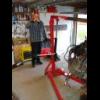Because the fit of front panels on a Mini can be problematic, I would suggest temporarily assembling the entire front end, bonnet and door, using whatever clamping devices are available, and adjust everything till you get proper panel gaps. Then adjust whatever needs adjusting (some hammer and dolly work is likely to be required somewhere), see where the A panel is positioned, and dimension the flange accordingly. Mark everthing carefully, and/or drill and Clecko it, so when you start to weld it all together, it goes back in the right place.
If the door gap is wrong, the A panel edge, and therefore the flange edge, is probably the easiest thing to adjust. If you can't, for practical reasons, such as not having the panels yet, or not enough clamps, fully assemble the front, you can just check the A panel to door gap, and set the flange width to get that correct, assuming your door is the original for that car, as they varied.
0.6" is in the right ball park. Replacement inner wings have a bit of tolerance on that dimension! When the A panel is folded over, there should be a gap between the edge of the folded part and the non-flange part of the innner wing panel, i.e. the fold does not completely cover the flange.
In that particular joint, I would suggest that as well as weld-through primer, you fold the flange almost but not quite right over, remove the A panel and fill the joint, and the A panel to scuttle joint, although that is sometimes brazed, with a weld-through structural adhesive, then put it back on and finish the fold with a door skinning tool, and do the 3 to 5 spot welds (one of my cars had 3, near top, bottom and middle, the other, 5, equally spaced) through A panel, flange and folded part, then of course some MIG weld top and bottom. The main function of the adhesive is to keep water out of the joint (a complete filling is better than brushed-on seam sealer), the spot and MIG welds are of course adequate structurally.
 DSCN5235.JPG 60.22K
40 downloads
DSCN5235.JPG 60.22K
40 downloads DSCN5233.JPG 45.57K
32 downloads
DSCN5233.JPG 45.57K
32 downloads













